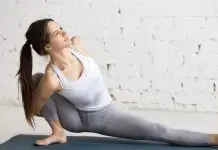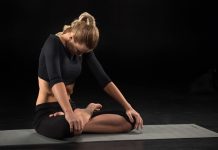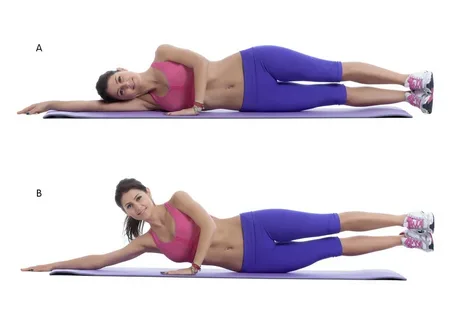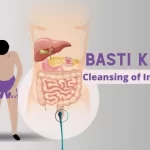The side-Lying Stretch Supported Side-Lying Stretch Pose is a gentle posture that provides a release for the sides of the body, opening the torso and stretching the intercostal muscles between the ribs. It can also help relieve tension in the shoulders. By practicing deep and calming breaths in this pose, the intercostal muscles between the ribs become more supple, allowing for an expansion of lung capacity.
I find this pose particularly beneficial when I notice that my breath is shallow and short. Engaging in deep breathing while opening the side body brings about a greater sense of emotional expansiveness and tranquility. Additionally, the shape of the body in this pose, resembling that of a banana, can evoke a lighthearted and playful sensation. I sometimes incorporate this pose into my practice when I desire a boost of playfulness and a lighter state of being.
Side-Lying Stretch Pose opening the sides of the body is also crucial for balancing subtle energy flow. The left side of the body is often associated with the “feminine” energy, representing emotions, feelings, and subjective aspects of behavior. It symbolizes intuition, receptivity, and our relational nature.
The left side can be seen as the aspect of “BEING.” On the other hand, the right side of the body is considered the “masculine” energy, embodying logic, analysis, objectivity, verbal communication, and direction in behavior. It governs initiation, giving, and our career-oriented aspects. The right side can be seen as the aspect of “DOING.” Opening both sides through this supported stretch and breath awareness offers a gentle way to harmonize and balance these integral aspects of our being.
Although this pose is usually classified as restorative, it can also serve as a warm-up for more active practices involving standing poses, back bends, and/or forward bends.
Side-Lying Stretch Pose on your side make it work for you
The beauty of a yoga practice is its flexibility (no pun intended!). That is, you can make adjustments to the positioning and use props. Try some of the variations below and make it work for you!
Time: 1-5 minutes per side.
Setting Up
To prepare for the pose, gather the following props: a yoga mat, 1 bolster, 1-2 blankets, and 1-2 blocks. Begin by laying the yoga mat flat on the floor. Position the yoga bolster horizontally in the center of the mat.
To Come into the Posе
Take a seated position on the mat in Vajrasana, with your hips resting on your heels. Ensure that your left side is facing the bolster. Then, gently rotate your body to the left, keeping your knees stacked on top of each other and your bottom foot resting on the mat.
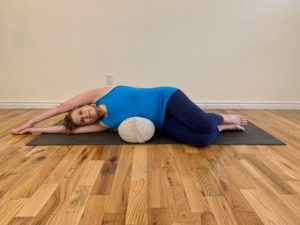
Shift your body towards the bolster until the left side of your waist, just above the hip point, makes contact with the edge of the bolster. Lower the left side of your torso onto the bolster, allowing it to rest between your hip and armpit. Ensure that the hip point is not directly on top of the bolster. Once you feel comfortable, let your body relax and drape over the bolster.
You have the option to straighten your legs, stacking them on top of each other. If this is uncomfortable, you can keep your knees bent and stack them on top of each other instead.
Extend your bottom arm above your head, reaching towards the opposite end of the mat, and use it as support for your head. Rest your head gently on your bottom arm, allowing your neck to relax.
Next, lengthen your top arm over your head, extending it in line with your body. You can choose to rest the top hand on the ground, use a prop such as a block or blanket, or place it on top of your other hand.
Find a comfortable position for your arms that allows for a gentle stretch and relaxation. Take a moment to adjust and ensure that your upper body feels supported and at ease.
Practicing the Pose
Allow the back of your neck to lengthen, gently releasing your chin towards your chest. Surrender the side of your torso to the support of the bolster, allowing it to sink and relax. Soften the side of your hip, thigh, leg, and foot, releasing them onto the mat.
Bring your awareness to the various points of contact between your body, the props, and the ground. Notice the sensations in these areas and allow yourself to fully settle into the support provided.
With each slow, deep breath, surrender your weight and melt into the support beneath you. Shift your focus inward and direct your attention to your breath. Inhale deeply, expanding your ribcage and softly relaxing the intercostal muscles between your ribs. As you exhale, release any tension or tightness.
Embrace the sensations in your ribcage and throughout the entire side of your body with an open and non-judgmental mindset. Observe any emotions that may arise, allowing them to be present without resistance. Stay in a state of loving awareness as you witness the changing sensations.
If at any point you experience pain or discomfort, honor your body’s signals and gently come out of the pose. Listen to your body and adjust as needed to ensure a safe and comfortable practice.
Side-Lying Stretch Pose during the exhalation, consciously release any tension, stress, anxiety, worry, and exhaustion, allowing them to dissolve. As you inhale, cultivate feelings of peace, self-love, and comfort, inviting them to fill your being.
Variations
If necessary, place a folded or tightly rolled-up blanket or block a few inches above the bolster to provide support for your head, as depicted in the photo above.
Position a block or blanket beneath the wrist and hand of either arm to offer additional support.
For individuals who are unable to fully extend the top arm over their head, they can keep the arm bent and rest the elbow on a blanket or block.
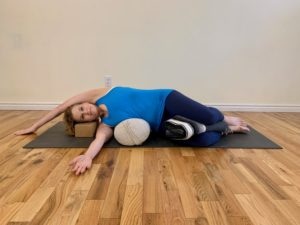
If extending the bottom arm overhead feels uncomfortable, they can extend it perpendicular to the body, as shown in the photo above, and rest the head on the bottom shoulder or a prop. Alternatively, they can bend the bottom elbow into a cactus position, allowing the bottom arm and hand to rest on the ground.
You can place a folded-up blanket under the knees and legs for additional support.
If you are practicing with bent knees in the pose, you can place a folded blanket between your knees as shown in the photo above to relieve your lower back or just to make the pose more comfortable.
Side-Lying Stretch Pose benefit
The Side-Lying Stretch Pose offers several benefits for the body and mind. Here are some of the benefits:
- The Side-Lying Stretch Pose is beneficial for releasing tension in the sides of the body, specifically targeting the intercostal muscles between the ribs. These muscles can often become tight and tense, leading to discomfort and restricted movement in the torso. By practicing the pose, the gentle stretch and support provided by the props help to release this tension, allowing for a sense of relief and relaxation. As the muscles in the sides of the body unwind, the overall sensation of tightness and discomfort in the torso is reduced, promoting a greater sense of ease and calmness.
- The Side-Lying Stretch Pose is effective in opening up the torso and enhancing flexibility in that region. As the intercostal muscles, which are located between the ribs, are gently stretched and lengthened in this pose, it creates space and freedom in the torso. This opening allows for improved mobility and range of motion in the upper body, promoting a sense of spaciousness and lightness. By regularly practicing this pose, the torso becomes more supple, making it easier to engage in various movements and postures that require flexibility and expansion in this area of the body.
- The Side-Lying Stretch Pose offers therapeutic benefits for alleviating shoulder tension. As you settle into the pose and allow the body to rest on the bolster or support, the shoulders are able to release and relax. The gentle stretch and support provided by the props help to ease tension in the muscles surrounding the shoulders, including the deltoids, trapezius, and rotator cuff muscles. By creating a supportive and nurturing environment for the shoulders, this pose encourages a sense of release and relief from any accumulated tension or discomfort in this area. Regular practice of the Side-Lying Stretch Pose can contribute to improved shoulder mobility and a greater sense of relaxation in the upper body.
- The Side-Lying Stretch Pose offers the opportunity to improve breath capacity and enhance the quality of breathing. By practicing deep and calming breaths while in this pose, the intercostal muscles between the ribs are encouraged to soften and relax. As these muscles become more supple, they allow for a greater expansion of the ribcage and an increased lung capacity. This can result in a deeper and more efficient breath, promoting a sense of calm and well-being. By consciously focusing on the breath during the Side-Lying Stretch Pose, individuals can cultivate a greater awareness of their breath patterns and use this practice as a tool for relaxation and stress relief. Regular practice of this pose can help individuals develop a more mindful and intentional relationship with their breath, leading to overall improvements in respiratory function and a greater sense of ease in daily life.
- The Side-Lying Stretch Pose offers not only physical benefits but also emotional and mental benefits. The shape of the body in this pose, resembling a banana, can evoke a sense of playfulness and levity, adding a light-hearted element to the practice. Additionally, focused attention on the breath and inward exploration can have a calming effect on the mind, helping to reduce anxiety and promote mental tranquility.
- By consciously observing the breathing and practicing deep, mindful breathing, individuals can cultivate a greater sense of emotional expansiveness and calmness. The pose invites individuals to turn their attention inward, allowing them to connect with their emotions and sensations without judgment. This self-awareness and mindfulness can contribute to a deeper sense of relaxation, creating a nurturing space for emotional well-being.
- Incorporating the Side-Lying Stretch Pose into a regular yoga practice can provide a holistic approach to emotional and mental wellness, combining the physical stretch with the nurturing qualities of breathwork and introspection.
Supported stretching pose lying on your side harm poses
While supported stretching poses lying on your side can offer numerous benefits, it’s essential to practice them safely and avoid any harmful poses. Here are a few precautions to keep in mind:
- Avoid excessive strain: Listen to your body and never push yourself beyond your limits. Respect your body’s capabilities and do not force any movements that cause pain or discomfort.
- Modify as needed: If you have any pre-existing injuries or medical conditions, consult with a qualified yoga instructor or healthcare professional to determine suitable modifications or alternative poses that won’t exacerbate your condition.
- Seek guidance: If you’re new to yoga or unsure about proper alignment and technique, it’s beneficial to learn from a certified yoga instructor who can provide guidance and ensure you’re practicing the poses correctly.
- Individualize your practice: Everybody is unique, so what works for one person may not be suitable for another. Pay attention to your body’s signals and modify the pose to suit your comfort level and physical abilities.
Digestive support
For students with gastrointestinal issues, this can be a helpful posture for releasing gas and getting the bowels moving.
Start by bringing your arms and legs to the left to lengthen along the ascending colon and then to the right to lengthen along the descending colon. This is nicely paired with the self-abdominal massage. You too can poop like a unicorn with these strategies and more.
Who is this posture good for?
This posture is particularly useful for helping manage constipation, abdominal bloating, painful periods, and endometriosis.
Enjoy and move easefully!
Conclusions
However, it is crucial to approach these poses with caution and listen to your body’s signals. Avoid overexertion or pushing yourself too far beyond your comfort zone. If you have any specific medical concerns or injuries, consult with a healthcare professional or qualified yoga instructor to ensure you are practicing the poses safely and effectively.
Remember, everyone’s body is unique, and modifications may be necessary to suit your individual needs and abilities. With proper guidance and a mindful approach, supported stretching positions lying on your side can be a valuable addition to your overall wellness routine.


